Charlemagne Peralte: Haitian Hero, ‘Supreme Bandit’ of First US Occupation – Part III
By Dady Chery
Haiti Chery
In 1917 Haiti, simultaneously with a U.S. military escalation that added tanks, seaplanes, airplanes, new aviation fields, and fresh Marines to the campaign against thousands of revolutionary Cacos, the State Department labored to legitimize the occupation.
Roosevelt’s pretty good little constitution
Franklin D. Roosevelt, then Woodrow Wilson’s Assistant Secretary of the Navy, drafted a foreigner-friendly constitution to be pushed on Haiti’s Parliament.
“I wrote Haiti’s Constitution myself, and if I do say it, it was a pretty good little Constitution,”
he would later boast. Among many measures favorable to the U.S., this constitution permitted foreign ownership of Haitian lands for the first time since the country’s independence. To counter this assault on sovereignty, the Haitian legislature drafted a stronger document that not only preserved all protections from the previous Constitution, but also invalidated the 1915 treaty between the U.S. and President Dartiguenave and called for his impeachment. As the legislators prepared to ratify this new constitution in early 1917, Major General Smedley Butler and President Dartiguenave declared the Parliament dissolved and blamed this move on “the spirit of anarchy which animates [the Parliament].”
Smedley Butler would receive a Congressional Medal of Honor for his work in Haiti but ultimately have a change of heart and go on to write:
“I spent 33 years and four months in active military service and during that period I spent most of my time as a high class thug for Big Business, for Wall Street and the bankers. In short, I was a racketeer, a gangster for capitalism.
- I helped make Mexico and especially Tampico safe for American oil interests in 1914.
- I helped make Haiti and Cuba a decent place for the National City Bank boys to collect revenues in.
- I helped in the raping of half a dozen Central American republics for the benefit of Wall Street.
- I helped purify Nicaragua for the International Banking House of Brown Brothers in 1902-1912.
- I brought light to the Dominican Republic for the American sugar interests in 1916.
- I helped make Honduras right for the American fruit companies in 1903.
- In China in 1927 I helped see to it that Standard Oil went on its way unmolested.
Looking back on it, I might have given Al Capone a few hints. The best he could do was to operate his racket in three districts. I operated on three continents.”
FDR’s good little constitution was imposed. Thus Haiti began a 13-year period without a legislature, and with continuous martial law and siphoning off of 40 percent of its gross domestic product by U.S. financiers.
The peasant defenders of sovereignty got no support from the Haitian elite. To this class, the most serious insult of the occupation was its exclusion from the society of U.S. managers due to race prejudice. Moreover, the upper class blamed the Cacos for threatening the public safety by drawing fire on them from the undiscerning Marines.
Popping off Cacos
The American military missions from the new airports became more and more frequent. Cacos were bombed if they could be found. And if they could not, villages were razed. When the U.S. militarily engaged the Cacos, the custom was to administer a bullet to the head of any wounded Haitian; those unlucky enough to be caught uninjured were usually tortured and lynched. Such practices are consistent with official U.S. documents on the “anti-banditry” campaign in Haiti, which are rife with reports of large numbers of Haitian casualties without prisoners, and few or no American deaths.
Stories of atrocities by the Marines became widespread and eventually reached the ears of James Weldon Johnson, who traveled to Haiti with an NAACP delegation to check their veracity. Johnson confirmed the reports with accounts such as these:
“…it has now become the duty and sport of American marines to hunt these ‘cacos’ with rifles and machine guns. I was seated at a table one day in company with an American captain of marines and I heard him describe a ‘caco’ hunt. He told how they finally came upon a crowd of natives having a cock fight and how they let them have it with machine guns.”
“I learned from the lips of American marines, themselves, of a number of cases of rape on Haitian women by marines.”
“Just before I left Port-au-Prince, an American marine caught a Haitian boy stealing sugar on the wharf, and instead of arresting him, he battered his brains out with the butt of his rifle.”
Promised land of jobs for deserving Democrats

James Weldon Johnson: author, diplomat, journalist, educator, lawyer, songwriter, and early civil rights activist.
In the late 1910’s and early 1920’s reports of this sort, some of them even more graphic and from first-hand sources, practically became a literary genre. But Johnson’s fact-finding mission stood out for exposing the hypocrisy of the sanctimonious do-gooders who created the conditions that gave license to the rank-and-file savagery.
“These Southerners have found Haiti to be the veritable promised land of ‘jobs for deserving democrats’…. In Port-au-Prince many of them live in fine villas. Many of them who could not keep a hired girl in the United States have a half-dozen servants. All of the civilian heads of departments have automobiles furnished at the expense of the Haitian Government… It is interesting to see with what disdain, as they ride around, they look down upon the people who pay for the cars.”
Johnson reported one Marine officer as remarking that
‘the trouble with this business is that some of these people with a little money and education think they are as good as we are…'”
and noted that
“…the man at the head of the customs service is a man who was formerly a parish clerk in Louisiana. The man who is second in charge of the customs service is a man who was formerly Deputy Collector of Customs at Pascagoula, Miss. The man who is Superintendent of Public Instruction was formerly a school teacher in Louisiana. It seems like a practical joke to send a man from Louisiana where they have not good schools even for white children down to Haiti to organize schools for black children. And the mere idea of white Mississippians going down to civilize Haitians and teach them law and order would be laughable except for the fact that the attempt is actually being made to put the idea into execution.”
Would an occupation by northerners have differed much from the one Johnson described? After all, the original architect of Haiti’s invasion was a New York banker.
Jean Baptiste Conzé, Haitian Judas
By 1919, Peralte’s formal declarations of war had demolished all pretexts of banditry, and the Cacos had become a force of over 40,000 that engaged the Marines over 60 times a month. It would have been impossible to capture the North and Artibonite regions, controlled respectively by Peralte and Battraville, without major casualties to the occupation. To demoralize the Cacos, the U.S. launched a secret mission to kill Peralte. U.S. Marine Sergeant Herman H. Hanneken was picked to head this mission because he was expert at cultivating spies from among Haiti’s elite.
After some months, Hanneken found Jean Baptiste Conzé: a greedy and vain Caco lieutenant who could be bought for $2,000 in cash and the promise of the rank of officer in Haiti’s armed forces. (Recall that government positions and high army positions had become the exclusive domain of white Americans.)
On the evening of October 31, 1919, Conze smuggled Hanneken and Corporal William R. Button, both in black face, together with 18 Haitian gendarmes, past all the guard posts of a Caco camp near Grande Riviere du Nord and into the section where Peralte himself sat by a fire. Hanneken shot two bullets at close range into Peralte’s back, instantly killing him, then the rest of the camp — about 1,200 men — was machine gunned in the surprise operation.
For his part in this massacre, Conzé was promoted as promised, and even decorated, but some of his relatives refused to bear his name. Hanneken and Dutton received the U.S. Medal of Honor
“for extraordinary heroism and conspicuous gallantry and intrepidity in actual conflict with the enemy… resulting in the death of Charlemagne Peralte, the supreme bandit chief in the Republic of Haiti, and the killing, capture and dispersal of about 1,200 of his outlaw followers.”
Hanneken would later get the Navy Cross for killing “Osiris Joseph, [another supposed] notorious bandit leader” in Haiti and a Gold Star for “zeal untiring… during active service in the Northern Area of the Republic of Nicaragua from 11 December 1928 until 30 June 1929.”
Return of the flag and Charlemagne

This photo of Charlemagne Peralte’s corpse tied to a door and with the Haitian flag around its head was dropped throughout Haiti on November 1, 1919.
On November 1, 1919, U.S. authorities photographed Charlemagne’s corpse tied to a door, with the Haitian flag around its head, and then dropped thousands of copies of the photo over the entire country. Later the same day, a group of Marines and Gendarmes buried the body in an unmarked grave.
The reaction to the famous photo of Peralte was not terror but revulsion. The majority of Haitians came to view the occupation as a project of “savages” and Peralte as a Christ-like figure, martyred for Haitian sovereignty.
With Peralte’s death, plus the death of Benoît Battraville in May 1920, the Caco strength diminished, but students, workers and intellectuals joined the cause of independence in solidarity with Haiti’s peasants. Student strikes and worker’s revolts became common. One notorious peasant protest in Les Cayes in December 1929, which left 12 killed and 23 wounded by U.S. Marines, was received with outrage by nearly all Haitian society and publicized abroad.
Loud calls by Haitians for U.S. departure were echoed by U.S. organizations like the suffragettes and the NAACP. In addition a shortage of investors, due to the stock market crash and Great Depression, made Haiti more difficult to colonize. Finally, U.S. President Herbert Hoover agreed to send his own fact-finding commissions to Haiti, which confirmed yet more atrocities, including widespread torture, a system of preventive detention, and the routine theft of Haitian property by U.S. Marines. Hoover accepted the commissions’ recommendations to withdraw.
By all accounts, the US occupation of Haiti was a colossal failure. James Weldon Johnson summarized this best.
“I made an honest effort to find out what things the Americans have done for the benefit of Haiti…. I found that only three things could be advanced, and they were: The Improvement of the public hospital at Port-au-Prince; enforcement of rules of modern sanitation; and the building of the great road from Port-au-Prince to Cape Haitian.
“The improvement in the hospital is a worthy piece of work but cannot be made to justify military occupation.
“The enforcement of certain rules of sanitation is not quite so important as it sounds, for the reason that Haiti, under native rule, has always been a healthy country and never subject to the epidemics which used to sweep the countries circling the Gulf of Mexico and the Caribbean Sea.
“The building of the road from Port-au-Prince to Cap Haitien is a monumental piece of work, but it is doubtful whether the Occupation had in mind the building of a great highway for the benefit of Haiti, or the construction of a military road which would facilitate the transportation of troops and supplies from one end of the island to the other. At any rate, the manner of building this road was one of the most brutal blunders made by the American Occupation in Haiti. It was built by forced labor.”
Legislative and presidential elections were organized so as to return Haiti to political autonomy. Haiti’s financial subservience to U.S. banks, however, would persist until 1945, and its military subordination would continue until the disbanding of the Forces Armees d’Haiti by President Jean-Bertrand Aristide. On July 5, 1934, Franklin D. Roosevelt returned to Haiti as U.S. President to recognize Haitian independence, and by mid-August the Haitian national flag was flying again.
Around the same period, Péralte’s remains were discovered with the help of a former Gendarme who had participated in the burial.
On November 26, 1934, Charlemagne Péralte was given a state funeral in Cap Haitien, attended by his mother, a large national corps, and an immense crowd. His marble headstone is engraved with the following Christian Werleigh poem:
“Dead at thirty three years of age, betrayed like Christ,
Exposed nude under his flag, crucified;
As one day he had dared to promise it to us,
And for our Nation he sacrificed himself.
Confronting the American, and alone to shout: ‘Halt’:
Let’s bare our head before Charlemagne Peralte!”
Recommended readings:
- Harvest of Hope: Kevin Pina Documentary on Haitian Army, With Review by Dady Chery
- The Truth about Haiti, an NAACP Investigation (By James Weldon Johnson)
- War Is a Racket (By Smedley Butler)
Sources: Haiti Chery | Thanks to Tortilla con Sal for republication


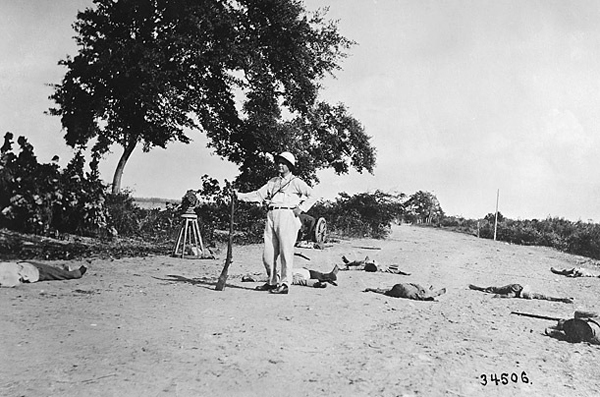
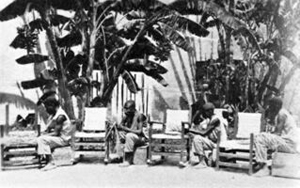
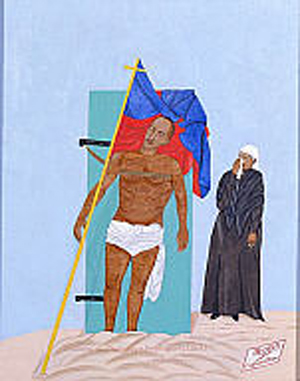


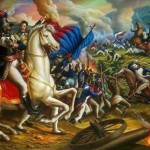


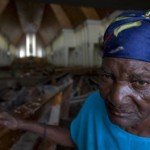
Comments
Charlemagne Peralte: Haitian Hero, ‘Supreme Bandit’ of First US Occupation – Part III — No Comments